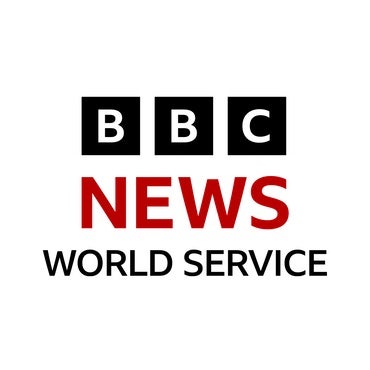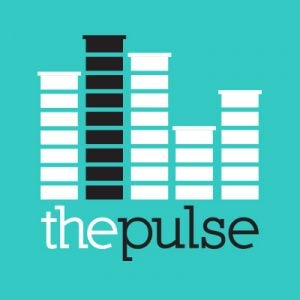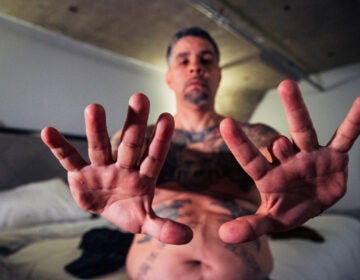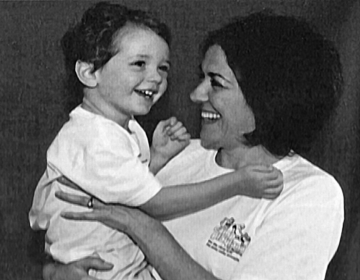Three years after the school shooting in Uvalde, survivors struggle to find ongoing support
On May 24, 2022, a shooter at Robb Elementary School in Uvalde, Texas killed 19 students and two teachers. Survivors still navigate barriers to getting support.
Listen 5:50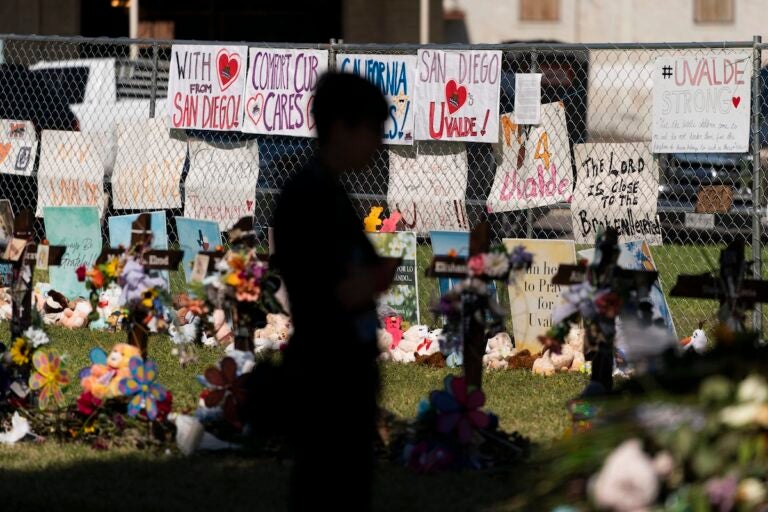
A woman visits a memorial honoring the victims killed in elementary school shooting in Uvalde, Texas, Friday, June 3, 2022. (AP Photo/Jae C. Hong)
This story is from The Pulse, a weekly health and science podcast. Subscribe on Apple Podcasts, Spotify, or wherever you get your podcasts.
Find our full episode on survival here.
This project was made possible with support from the Commonwealth Fund, The Carter Center, the Economic Hardship Reporting Project, the Mesa Refuge and is co-published by WHYY’s The Pulse, El Diario de NY and La Cronista.
“I closed the door! I closed the door!” Amy Franco shouted repeatedly from her emergency room bed. It was May 27, 2022, three days after the horrific mass shooting at Uvalde’s Robb Elementary School, the deadliest school shooting in Texas history. Franco, a former Robb Elementary School educator, was being treated for an anxiety attack. She had just watched a televised briefing where officers explained how the gunman entered the building, wrongfully blaming her for leaving a door propped open, a claim later refuted by video footage.
Franco had closed the door as she ran into the school to warn children and staff of the shooter. But the emotional damage, caused by the police statements, she said, had already been done.
“I died that day,” Franco said.
It has been more than three years since Salvador Ramos killed 19 children and two teachers with an AR-15 style rifle and injured 17 others in one of America’s deadliest school shootings. Franco is still scrambling to find the person that she used to be. “It’s a struggle mentally, physically (and) emotionally,” she says.
Franco embodies many of the burdens faced by shooting survivors as they grapple with physical injuries, trauma, grief and depression; the long-term financial hardship, endless paperwork to access care, denied workers’ compensation and other bureaucratic tasks. And in Franco’s case, the loss of her home. But in Uvalde, the deadly attack also further fractured the social fabric of this rural, predominantly Latino community.
Located 54 miles from the Southern border, Uvalde has about 15,300 inhabitants. With a 26.3% poverty level, this small town was already facing challenges prior to the shooting, including limited access to mental health support, and for some students, even access to basic needs. In minutes, the attack turned the lives of victims’ families, survivors and the working-class community upside down.
The struggle to find help
Franco’s struggles can be heard in her voice and seen in her body. During our interview, her body shook uncontrollably as she spoke. She became angry and fought back tears as she recalled the sting of hearing law enforcement wrongly blame her for something she didn’t do. “Did they hope that the shooter had killed me and their story would stick?” she wondered.
“It was all triggered from that day,” she said.
Subscribe to The Pulse
At home, Franco keeps all the windows and curtains closed to stay in the dark. She is scared of going outside to empty the trash or check her mail. She is being treated for PTSD, depression and anxiety, and walks with a cane due to a foot injury sustained the day of the attack. But her injury claims have been denied. “That’s a battle in itself, and it’s awful”, she says. Even when claims are approved, she explained, “it’s insane how much it takes to find a doctor who takes workers’ comp.”
In the past three years, Franco has gone through multiple mental health counselors. “It’s sad because you’d want to stick to one therapist,” she said. She wanted to try an approach called Eye Movement Desensitization and Reprocessing, EMDR– a psychotherapy technique used to help patients process traumatic experiences. But when she finally found a provider who specializes in this technique, Franco says she had to quit because workers’ compensation never processed any payments, and she could not afford the services. She is now working with a therapist at the Resiliency Center, which offers free services.
After the shooting, Franco never went back to work and eventually retired. She’s 60 now. She has been depending on the welfare system and her children to stay afloat. But following the latest workers’ compensation assessment, she received bad news: her weekly payments were reduced from $487 to $315. She has been struggling to make ends meet since she moved out of her daughter’s house more than a year ago. Now, there’s a small ray of hope, and she’ss on a waitlist for a one-year rental assistance program, but payments could take another year to come –– and only if the program receives funds.
Unlike other impacted families who gave up on the burdensome paperwork and application process, Franco applied and received monetary assistance from The Texas Attorney General’s Crime Victims’ Compensation (CVC) Program for one year. Then, checks stopped.
“I applied (for) the second year, thinking, ‘OK, you know? It’ll help me.’ But they sent me a $2,000 check and said: ‘You have already exceeded the amount that can be funded for you,’” she says. Now she fears her workers’ compensation payments will meet the same fate.
Since the shooting, Franco said she’s been broken by the lack of support and continued bureaucratic barriers. She said not a day goes by without her wishing she had been killed by the shooter. Her emotional scars run deep, and so does her frustration that no centralized efforts were set up to provide critical assistance to survivors and impacted families. Despite the initial influx of agencies coming in to help in the immediate aftermath of the shooting, there was too much chaos happening all at once. She said most organizations vanished after a while. And she did not know where to turn for help, even if it was available.
According to an email statement provided by the Texas Department of Health Services (HHSC), in the aftermath of the tragedy, Texas invested an initial $5 million for the Uvalde Together Resilience Center to serve as a hub for community services, including crisis counseling and behavioral health services. The state also provided $1.25 million to the Uvalde Consolidated School District (UCISD) for counseling, trauma-informed care, crisis intervention, and community outreach efforts for students and faculty. The Uvalde Mayor’s Office did not respond to multiple requests for comment and the Uvalde Consolidated Independent School District did not make a spokesperson available for an interview.
But Franco said she had to learn how to navigate the post-school mass shooting system by herself, and word of mouth among survivors and victims’ families became an important resource to learn of and access services.
This is how she found out about the generosity of Father Michael K. Marsh, a former attorney. Franco paid him a visit at Uvalde’s St. Philip’s Episcopal Church and asked for gas money to travel to San Antonio to see a doctor. When she got up to shake his hand and receive the check, her jaw dropped. “The check was for $1,000,” she said. Franco used the money to pay her rent. “I got to make sure I have my home,” she said.
Since that visit, Franco has been reluctant to seek further assistance from the church. “I don’t feel comfortable because … I was always brought up that you’re supposed to work. You’re supposed to be self-sufficient,” she said.
A lifeline for victims
From the start, Marsh has been at the heart of efforts to provide financial assistance and spiritual guidance to impacted families, alongside the Sacred Heart Catholic Church and the volunteer fire department. “I think a lot of them (the affected families) were already struggling financially and the shooting created additional problems,” he said. One mom quit her job to homeschool her son and she can no longer pay her bills. Other families, he explained, miss work to get medical care or counseling in San Antonio and need help to cover bills. Marsh used money donated from people across the country to help families pay for living expenses, including food, rent and utility bills until November 2022. Marsh also provided assistance to the shooter’s family and lit 22 candles in memory of the 21 victims and the perpetrator. The latter move, however, did not sit well with some.
“Who am I to exclude him?” he said. “I can’t help but wonder what exclusions he felt along the way that might have contributed to this.”
Despite his dedication, Marsh knows money alone won’t facilitate healing in the community, and difficult conversations about unresolved grief, anger, conflict and different experiences have to happen.
Healing the tensions and rifts
Marsh said the shooting created divisions between the families who lost loved ones and those whose loved ones survived, as well as tension between those who support the law enforcement response and those who do not. Also, while some in the community are ready to move on, many of those directly impacted, aren’t, he said. “It is going to take decades to heal.”
Without a centralized group to lead the response, Marsh noted, the community has no place to express their different experiences, have their pain and struggles acknowledged and find a path to move forward. Building a path forward will require embracing the pain and having difficult conversations about loss, death, grief and mortality.
“Those conversations happen more in one-on-one situations or small groups, because they’re vulnerable conversations, and they’re conversations of the heart, not the head,” he says.
After the shooting, Marsh was also instrumental in helping to set up The Children’s Bereavement Center, a permanent mental health center steps away from St. Philip’s providing free services in English and Spanish to the community.
Over the years, the center went from two counselors to a larger team. They currently offer over 100 appointments a week to individuals ranging from 3 to 70 years old –– most clients are minors and 10% are adult Hispanic males, says Brenda Faulkner, who relocated from Dublin, Texas, to Uvalde to run the center. She said she’s worked to create a safe environment in a community where there may be stigma around therapy, or where people may not see its value. She says each person has to process trauma, death and grief at their own pace.
“You lose someone that’s dear to you, whether it’s a classmate, as in the case of Robb, and then you’re expected in three days to have worked through all of the grief and the loss,” she said. “That’s just not realistic.”
Faulkner also said that the economic challenges faced by many families in Uvalde have turned recovery into an uphill battle. “A lot of people are poor. So they don’t have the resources that maybe they would have in Parkland or in other places,” she explained.
Creating a Bond and Support Network in Traumatic Times
While some families have utilized these free services provided, others have found different ways to support each other. Three mothers of victims ––Gloria Cazares, Kimberly Mata-Rubio and Verónica Mata–– have bonded over the loss of their children: Jackie, Lexi and Tess. Together, they lead Lives Robbed, an Uvalde-based nonprofit organization supporting families whose children were killed at Robb Elementary. They are committed to honoring their legacies by fighting to reduce gun violence.
A September 2024 report shows that between 2020 and 2023, gun violence has been the leading cause of death for children and teenagers up to 17 years old in the U.S. While people of color are disproportionately affected, the gun homicide rate among male Hispanics increased by 70% from 2013 to 2022.
After losing Jackie, Cazares felt numb. She quit her job as a home health nurse for one year. But, for the past two years, she’s channeled her loss into action and used money from advocacy organizations to support her efforts to raise awareness about gun violence. She’s made trips to Washington D.C. and Austin. . When that work slowed down another shift happened in her emotional state. “I don’t know if I’m finally letting myself grieve, but it’s a lot harder to get myself out of bed,” she said.
Cazares has not sought any counseling but knows she is probably at a point where she needs it. Her husband, a glass worker who has only had gigs here and there since losing their little girl, received therapy earlier on but quit when he had to change counselors.
Mata-Rubio moved out of her home after Lexi’s murder because their landlord was a police officer, which she said created additional tension and concerns. She, her husband and five children struggled to find a new place for their large family.
Her daughter’s murder also derailed her career: she quit her job as a crime reporter at the local paper and transferred to the sales department. Although she has devoted much of her time to advocacy efforts and even ran for Mayor of Uvalde, her heartbreak has not diminished.
Mata-Rubio, Cazares and Mata have forged a years-long judgment-free alliance to share their struggles, feelings and memories. For all three, Lives Robbed is a safe space that makes up for the lack of the centralized community support committee they wish they had had.
As the group continues advocating for children, Father Michael K. Marsh is ready to pack his bags and say goodbye. After 20 years as the head of the St. Philip’s Episcopal Church, he retired in July –– a huge blow to a community that has not found its way out of the tragedy. But wherever he goes, Uvalde will always remain in his prayers.
“In some ways, they’re (the community) treating the symptoms, but not the disease (gun violence, economic inequality and systemic barriers). And we’ve got to move to treat the disease,” he said.
WHYY is your source for fact-based, in-depth journalism and information. As a nonprofit organization, we rely on financial support from readers like you. Please give today.
